| History of Mozambique |
|---|
 |
This is a survey of the postage stamps and postal history of Mozambique.
| History of Mozambique |
|---|
 |
This is a survey of the postage stamps and postal history of Mozambique.
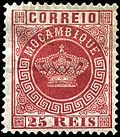
Stamps date from 1877, with the same key type design of the Portuguese crown as used elsewhere in the Portuguese territories. The original nine values were followed up by color changes in 1881 (10r and 40r) and 1885 (20r, 25r). These were followed by the King Luiz issue in 1886. [1]
In the 1890s, stamps were issued for the districts of the colonial administration, Zambezia, Inhambane, and Lourenço Marques and the district of Mozambique, for use in each area. In 1898, King Carlos I was the subject of a lengthy series, which by 1903 numbered 23 colors and denominations. [2] [3] [4]
In 1913, the postal districts of Quelimane and Tete were created from Zambezia and separate stamps were issued. All districts shared the Ceres design. Issues for the districts ended in 1920, in favor of stamps valid through Mozambique. [5] [6]

The 1910 revolution resulted in a variety of overprints reading "REPUBLICA" on both the existing stamps, and on previously-unissued stamps depicting Manuel II of Portugal.
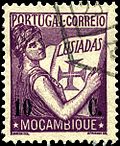
Various expediencies required a variety of surcharged stamps throughout the 1920s. In 1933, the Lusiad issue became standard, followed by the Empire issue in 1938.
Postwar issues followed the general pattern for the Portuguese colonies. A definitive series of 1948 featured a variety of local scenery, while a 1951 series of 24 stamps depicted fish in full color. A 1953 series showed butterflies and moths, while the 1961 series included the coat of arms of various Mozambique cities. The 1963 series showed historic ships, while in 1967 the theme was soldiers.

The Lusaka Agreement of 1974 was marked in January 1975 with a philatelic design consisting of a stylized bird formed from Portugal's and Mozambique's flags. On June 25, 1975, many existing stamps, some going back as far as 1953, were issued with an overprint marking independence.
Issues of independent Mozambique have been relatively restrained and focus on local subjects. Philatelic issues are frequently released in sets of four-to-six stamps. For instance, in 1985 there were 10 issues, of which three were single commemoratives, five were sets of four, and the remaining two were sets of six.
The Kionga Triangle was a tiny territory on the border between German East Africa (present-day Tanzania) and Portuguese Mozambique occupied by the Portuguese forces in 1916. On May 29, 1916, stamps from Lourenço Marques were overprinted "KIONGA".
In 1891 the Mozambique Company was chartered to administer the Manica and Sofala areas, for which they issued their own stamps until 1942. [7]
They were followed by the Nyassa Company in 1898, whose stamps continued until 1929. [8]

Portuguese Mozambique or Portuguese East Africa were the common terms by which Mozambique was designated during the period in which it was a Portuguese colony. Portuguese Mozambique originally constituted a string of Portuguese possessions along the south-east African coast, and later became a unified colony, which now forms the Republic of Mozambique.
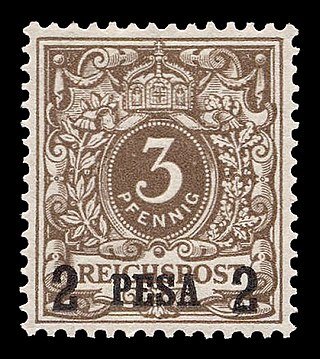
This is a survey of the postage stamps and postal history of German East Africa.

On 1 January 1868, Portugal issued postage stamps for the islands of Madeira, consisting of the current stamps of Portugal overprinted "MADEIRA". Subsequent stamps were also overprinted, through 1881.
This is a survey of the postage stamps and postal history of British East Africa.
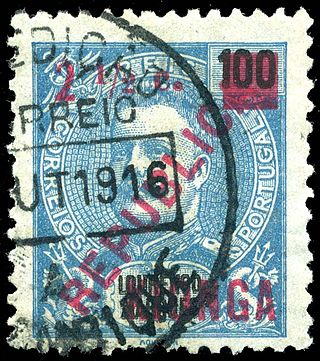
The Kionga Triangle was a tiny territory on the border between German East Africa and the Portuguese colony of Mozambique, originally Portuguese, but occupied by German forces in 1894, and recaptured by the Portuguese forces in 1916. The triangle was the only German territory that the post-war Treaty of Versailles awarded to Portugal.
As with several other districts of colonial Mozambique, the Portuguese government printed postage stamps specifically for Inhambane for several years. The first issue was for the 700th anniversary of St. Anthony of Padua in 1895, the stamps being those of Mozambique overprinted "CENTENARIO / DE / S. ANTONIO / Inhambane / MDCCCXCV". This was followed up in 1903 by a regular set featuring a portrait of King Carlos and inscribed "IMHAMBANE". The replacement of the monarchy by a republican regime in Portugal in 1910 resulted in a variety of "REPUBLICA" overprints until 1917. Subsequently, Inhambane reverted to the use of the stamps of Mozambique.
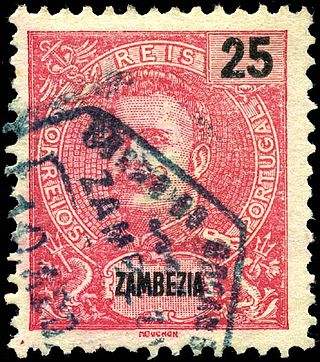
Although Zambezia was a part of the Portuguese East Africa Colony, the Portuguese government-issued separate postage stamps for it starting in 1894, with the standard design depicting King Charles, and likewise in 1898. A provisional issue came in 1902 to reflect changed rates, then after the revolution of 1910 there were several issues overprinted "REPUBLICA". The postal districts of Quelimane and Tete were created from parts of Zambezia in about 1913, and then stamps of Mozambique replaced stamps of Zambezia around 1920.
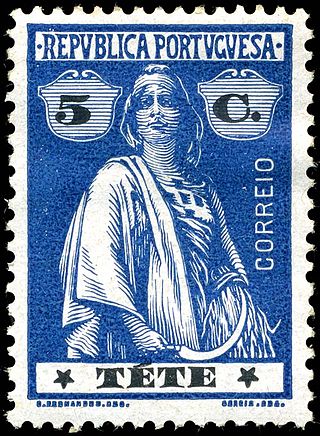
In 1913 and 1914, Portugal issued postage stamps specifically for Tete Province, now part of Mozambique.
This is a survey of the postage stamps and postal history of Macau.
Each "article" in this category is a collection of entries about several stamp issuers, presented in alphabetical order. The entries are formulated on the micro model and so provide summary information about all known issuers.

The Ceres series of Portuguese postage stamps is a definitive series depicting the Roman goddess Ceres that was issued between 1912 and 1945 in Portugal and its colonies.

The postage stamps of Ireland are issued by the postal operator of the independent Irish state. Ireland was part of the United Kingdom of Great Britain and Ireland when the world's first postage stamps were issued in 1840. These stamps, and all subsequent British issues, were used throughout Ireland until the new Irish Government assumed power in 1922. Beginning on 17 February 1922, existing British stamps were overprinted with Irish text to provide some definitives until separate Irish issues became available within the new Irish Free State. Following the overprints, a regular series of definitive stamps was produced by the new Department of Posts and Telegraphs, using domestic designs. These definitives were issued on 6 December 1922, the day that the Irish Free State officially came into existence; the first was a 2d stamp, depicting a map of Ireland. Since then new images, and additional values as needed, have produced nine definitive series of different designs.

The story of the postage stamps and postal history of Yugoslavia officially begins with the formation of the Kingdom of Serbs, Croats and Slovenes on 1 December 1918.
This is a survey of the postage stamps and postal history of Angola.

This is a survey of the postage stamps and postal history of Serbia.

Postal history in the territory that now constitutes Latvia began during the 13th century, when the Archbishopric of Riga was included to the area of postal operations of the Monastic state of the Teutonic Knights and the Hanseatic League. In 1580 the Hanseatic League issued their first known regulations on courier work and payroll, regulations that also were active in the territory that now constitutes Latvia.

This is a survey of the postage stamps and postal history of Fezzan and Ghadames, both now part of Libya.

This is a survey of the postage stamps and postal history of the Nyassa Company.

This is a survey of the postage stamps and postal history of the Netherlands East Indies, otherwise known as the Dutch East Indies, and which today is known as Indonesia.